Meredith Gamer
The Past—or, more accurately, pastness—is a position.
Thus, in no way can we identify the past as past.
— Michel-Rolphe Trouillot, Silencing the Past (1997)[1]
On December 1, 1783, London’s Gentleman’s Magazine presented its readers with a precisely executed picture of the city’s newest execution machine (Fig. 1). Jutting out from the hulking stone façade of Newgate Prison, the apparatus consists of a raised wooden platform, on which stand two sturdy timber posts joined by a pair of parallel beams. A low chain-link barrier marks off the space immediately below, where a second, smaller platform protrudes slightly from its surround. This, the alphabetized legend and accompanying text explain, is a trap door. Hidden underneath is a moveable metal frame configured in such a way that when “The Pin” (marked “I”) is removed, the platform falls away, “which has the effect of immediate death” for anyone unlucky enough to be hanging from the gallows above.[2]
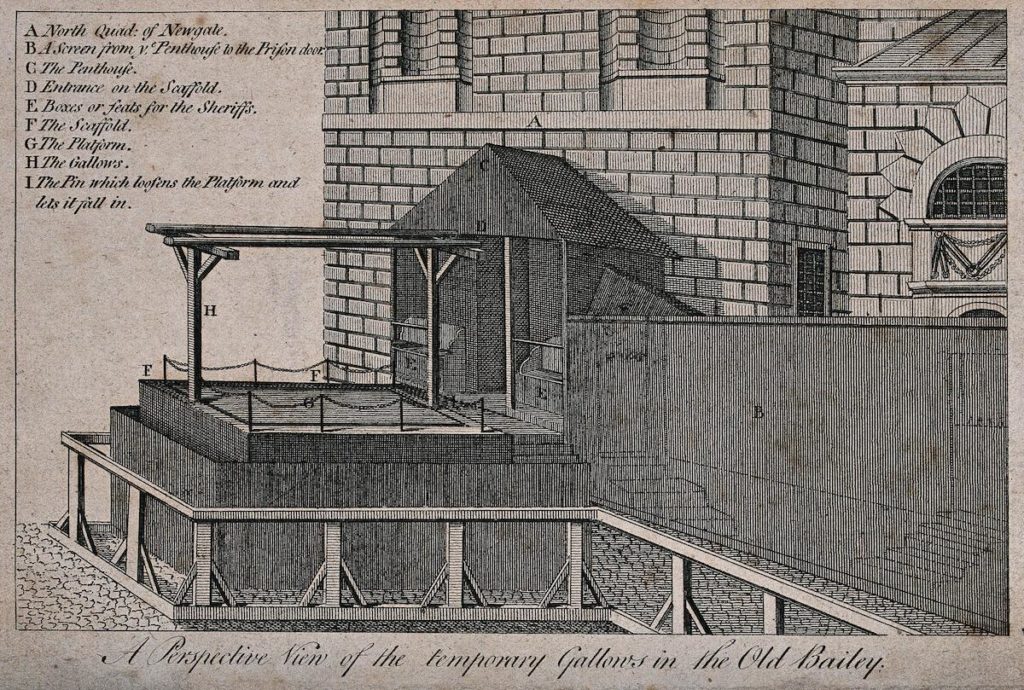
Designed and built less than a decade before revolution broke out in France, the “Newgate Drop,” as it would soon come to be known, has attracted far less attention from historians of European art than its cross-Channel counterpart, the guillotine.[3] Yet for much of the eighteenth century, the majority of public executions in western Europe were carried out not by beheading, but by hanging, and the highest concentration of such punishments was not in France, but in Britain. In London especially, hangings were frequent and familiar events, thoroughly interwoven into the fabric of everyday life. The same was true to varying degrees in cities and settlements across Britain’s empire, which reached from North America and the Caribbean to India and Oceania.
What would it mean, this article asks, to consider the history of eighteenth-century spectacular violence from the vantage point of the British gallows instead of the French guillotine? How might our picture of the period change? What new inheritances could this reorientation make visible? As scholars have long noted, the guillotine, like the Revolution that created it, lends itself readily to narratives of rupture: the severing of body from head, past from present, old orders from new.[4] By contrast, the visual culture of Britain’s gallows demands that we recognize the “long” eighteenth century as an era of significant continuity, as well as change, in the practice and representation of state terror in Europe and its colonies. More ancient than the guillotine, the gallows was also a more fluid, malleable, and enduring technology, the afterlives and legacies of which persist to this day.
In what follows, I develop these arguments through a pair of contrasting case studies. The first centers on the Newgate Drop. With the introduction of this “elegant contrivance,” as one contemporary called it, London’s age-old execution ritual underwent a renovation at once technological and aesthetic.[5] The new machine formalized and modernized the practice of hanging in Britain by mechanizing the act of execution, and by introducing a degree of order, propriety, and ostensible humanity into what had formerly been a messy, unpredictable, and visibly painful mode of death. In these respects, the Newgate Drop—like the guillotine—marks a key inflection point in the transition Michel Foucault traced, in his classic analysis of the history of punishment in the West, from an “old” penal style defined by tortures meted out on the body, to a “new” one epitomized by the disembodied panopticism of the prison.[6]
My second case study shifts attention to Britain’s colonies, specifically to the colony of Demerara in present-day Guyana. In 1823, Demerara’s enslaved population rose up in a rebellion that was quickly and brutally suppressed by the colony’s white planter class. In the days and weeks that followed, dozens of captured rebels were hanged and, in many cases, their corpses dismembered, desecrated, and publicly displayed. A rare set of prints produced by the colonial British artist Joshua Bryant documents these acts in exhaustive detail. Bryant’s images make clear that in Demerara, as elsewhere in the British Caribbean, execution rituals were deliberately not“modernized”—not cleaned up or made neat—precisely so as to assert and reinscribe the vast asymmetries of power between punisher and punished. In doing so, they point to the limits and occlusions of Foucault’s influential account and lay bare the deep colonial roots of subsequent and ongoing forms of racial terror worldwide, including the long history of lynching in the United States.
I address Bryant’s images and accompanying text mindful of the dangers that sources like them pose—dangers that Saidiya Hartman has explored with nuance and complexity in her work on the history and afterlives of Atlantic slavery.[7] As she has argued, to narrate the history of slavery is to narrate a history of violence, for it is precisely violence that defines “the state of blackness and the life of the ex-slave.”[8] And yet, to do so is also to risk committing violence of one’s own, both by reiterating past harms and by affirming the logic and authority of the colonial archive that has recorded them for posterity. These risks are particularly acute in the case of images such as Bryant’s, because the visibility of the enslaved and their descendants has long been and still remains closely imbricated with acts of subjection.[9] As Temi Odumosu has recently suggested, such images call for their own ethics of care, one that is right now in the process of formation.[10] It is for these reasons that I have blurred what may be, for many readers, the most troubling of Bryant’s plates, allowing them the option of following a link to view it in full. And for these reasons, too, I conclude with a work by Kara Walker, Fons Americanus (2019), which traced the shadow of Britain’s gallows into our collective present, while mounting a critique of the dehumanizing horrors it produced.
London, 1783
No one knows exactly when hanging first began, but given that rope is among the oldest of human tools, it was likely a very long time ago.[11] The practice is mentioned in Homer’s Odyssey, archaeological finds place it in Iron Age Scandinavia, and the Roman historian Tacitus, writing in the first century AD, associated it with the Germanic tribes of Northern Europe.[12] Some eight hundred years later, the traveler and theologian Ahmad ibn Fadhlan observed it in use among the Volga Bulgars, in what is now Russia. “If they catch a thief or a robber,” Ibn Fadhlan writes, “they lead him to a thick tree, throw a trusty rope around his neck and hang him to the tree, and he remains hanging until with the wind and rain he falls to pieces.”[13]
Over time, trees were replaced by purpose-built wooden gallows. However, the connections that Ibn Fadhlan describes between hanging, nature, and the elements persisted well into the medieval and early modern era. In cities and towns throughout Europe, authorities typically erected gallows in open fields or along major thoroughfares to maximize their visibility to incoming visitors. The corpses of hanged felons were often left to decompose over weeks and months, a process captured with unflinching attention by the fifteenth-century painter Antonio Pisanello (Fig. 2). In this way, the apparatus of punishment and the punished body itself became features of the landscape and public monuments of a sort, confronting any who saw them with a twin message of “fright and caution.”[14]
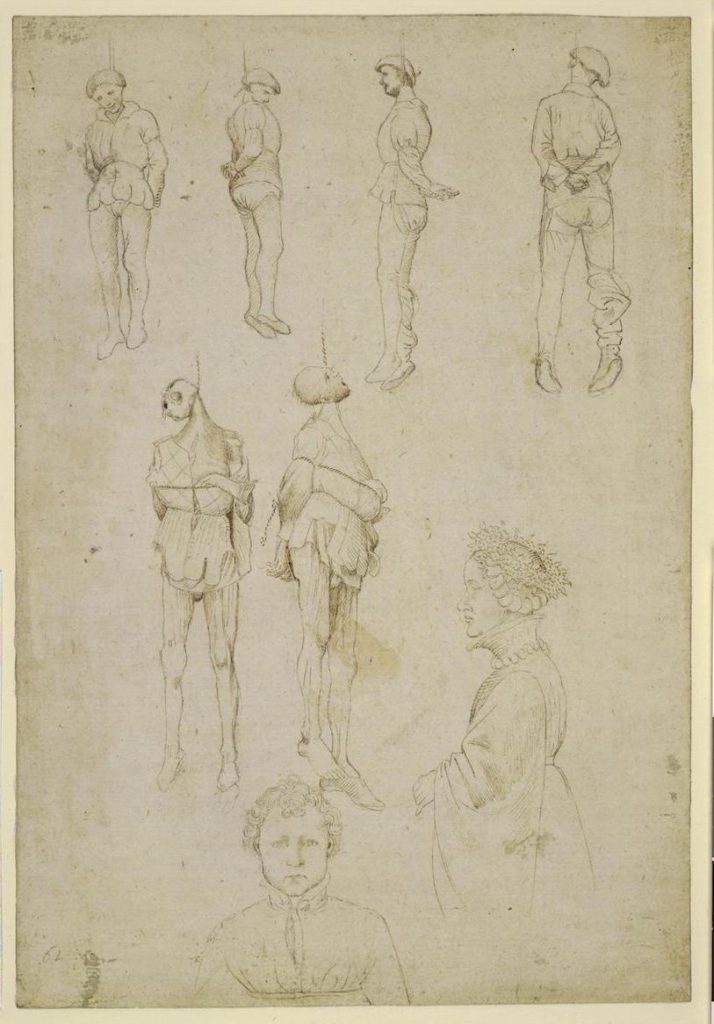
Hanging continued across Europe until well into the eighteenth century. But it flourished and evolved most actively in Britain, where capital codes grew harsher over time, even as they softened elsewhere. Beginning in the late seventeenth century, Parliament added hundreds of new capital statutes to the law books, nearly all of them for offenses against property.[15] As a result, British execution rates soon came to far outstrip those on the continent.[16] According to the most recent calculations, roughly thirty people per year—perhaps some three thousand in all—were hanged in London over the course of the eighteenth century.[17] By contrast, in pre-Revolutionary Paris, annual averages hovered at five or six.[18] In Brussels, only forty people were executed during the whole century; in Florence, four.[19]
Before the construction of the Newgate Drop, the vast majority of executions in London took place at Tyburn gallows, located at what was then the westernmost edge of the city. In technical terms, these were crude affairs. The condemned were made to stand on a horse-drawn cart, while the hangman and his assistants readied the noose and tied it to the gallows. Then, once everything was set, the cart was abruptly driven away. In early modern Britain, hanging was often characterized as an “easy death,” and the woodcut illustrations that commonly ornament contemporary executions ballads and chapbook accounts would seem to confirm this impression (Figs. 3 and 4).[20] Here, the condemned appear as small, dark figures, suspended and silhouetted against the gallows’ square frame. Their bodies are so perfectly still that it is unclear whether they are dead or alive; whichever the case may be, they show no sign of movement, let alone suffering or pain.
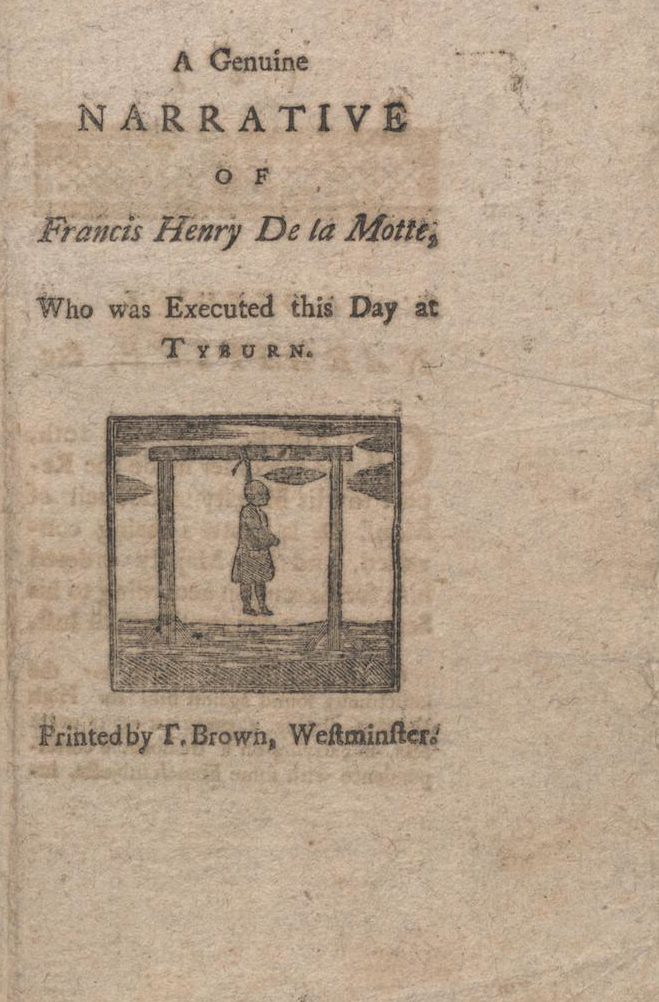
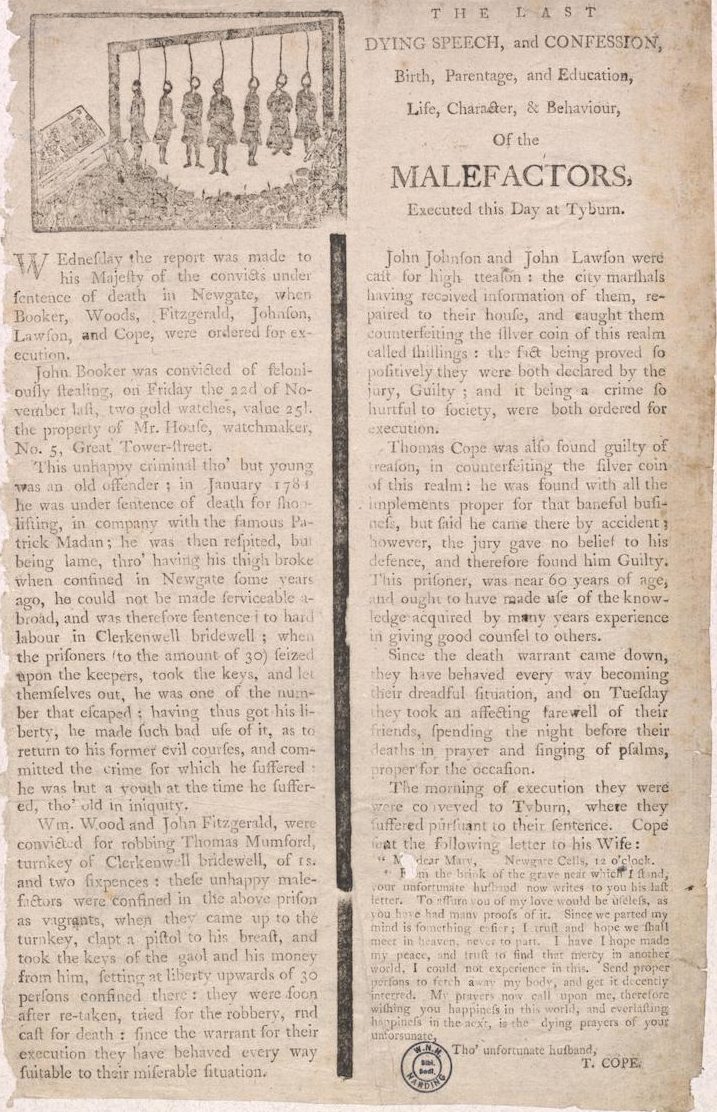
Yet such hangings were painful, often excruciatingly so. It could take many minutes for the condemned to lose consciousness, and far longer for their heart to stop beating. During this time, their bodies might convulse, bowels evacuate, eyes bulge, and mouths froth.[21] Eighteenth-century British slang spoke vividly to these effects. To hang was to “dance the Tyburn jig,” to “dance upon nothing,” or to “choke on a hempen quinsy” (a “quinsy” being a kind of inflammation of the throat). It was to be “twisted,” “stretched,” or to “swing.” A hanging day was a “wry neck day,” and a hanged man one who “will piss when he can’t whistle.”[22] It was standard practice to leave the condemned dangling for a full hour before cutting them down, and even then some were found to be still living.[23]
A rare ink and wash sketch of a hanging at Tyburn by Marcellus Laroon II strongly conveys the rough-and-ready nature of these events (Fig. 5). Spectators mill in and out of the gallows’ tripartite frame—Tyburn’s famous so-called “Triple Tree”—as six psalm-singing men are tied up, one by one. A stray dog meanders between the cart’s wheels, and there is a hurried, haphazard quality to the proceedings. It is perhaps unsurprising, in light of this scene, that botched executions were common. Newspapers regularly report instances of knots slipping or ropes breaking, of bodies twitching for minutes on end, or caps falling to reveal grotesquely distorted features, blackened and bruised by the sudden rupture of blood vessels beneath.[24] Even when hangings went according to plan, it was still considered a mercy for those standing nearest to the gallows to pull on the legs of the condemned in order to kill them more quickly.
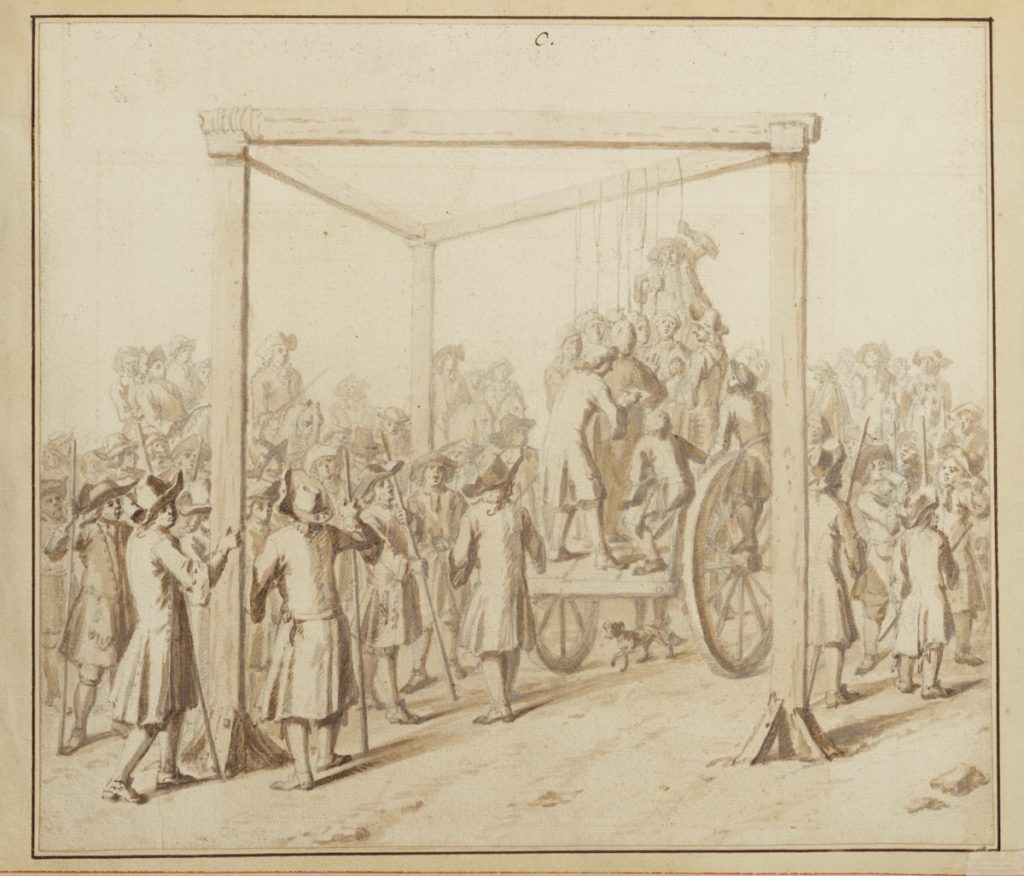
The new gallows at Newgate was meant to reform and sanitize this timeworn practice. The decision to build it was made by city sheriffs Thomas Skinner and Barnard Turner, who began their terms just a few months before the new machine was unveiled.[25] In their Account of Some Alterations Attempted in the Duty and Office of the Sheriff of the County of Middlesex and Sheriffs of the City of London (1784), Skinner and Turner include an extended footnote spanning the better part of two pages, in which they detail the precise dimensions and component parts of the Drop, as well as its mode of use and operation. Clinical, detached, and scrupulously exact, their tone perfectly mirrors the apparatus they describe:
The Scaffold is erected before the Debtors Lodge. … In the Middle of this Machinery is placed a moveable Platform, in the Form of a Trap-Door, 10 Feet long by 8 Feet wide, over the Middle of which is placed the Gibbet, extending from the Jail across the Old Bailey. This moveable Platform is raised 6 Inches higher than the Rest of the Scaffold, and on which [sic] the Convicts stand; it is supported by two Iron Bars, 6 Feet long, secured to the under Side of the Platform; at the lower End of the said Bars are fixed two Rollers to run upon a sliding Bar. … At the Head of this Slider is fixed a Lever, whose Handle comes above the Scaffold; and the Convicts, standing on the Platform, being tied to the Gibbet, when the Signal is given, the Executioner, by a very small Force applied to the Handle of the Lever, slides the Bar into its Place, and the Platform falls from under them; and, by the Quickness of its Motion, it is observed to put the unhappy Objects out of Pain in much less Time than was usual at Tyburn.[26]
At this new gallows, everything is meticulously managed and controlled. The various rollers, sliders, and beams needed to make it work are completely hidden from view, save for “a Lever,” which peeks out above the scaffold and may be released by just “a very small Force.” Once triggered, the trap door opens so quickly that the condemned—we are told—are “put … out of Pain” much faster than was the case at Tyburn. Efficient, humane, and technologically advanced: the guillotine would soon be celebrated in much the same terms.
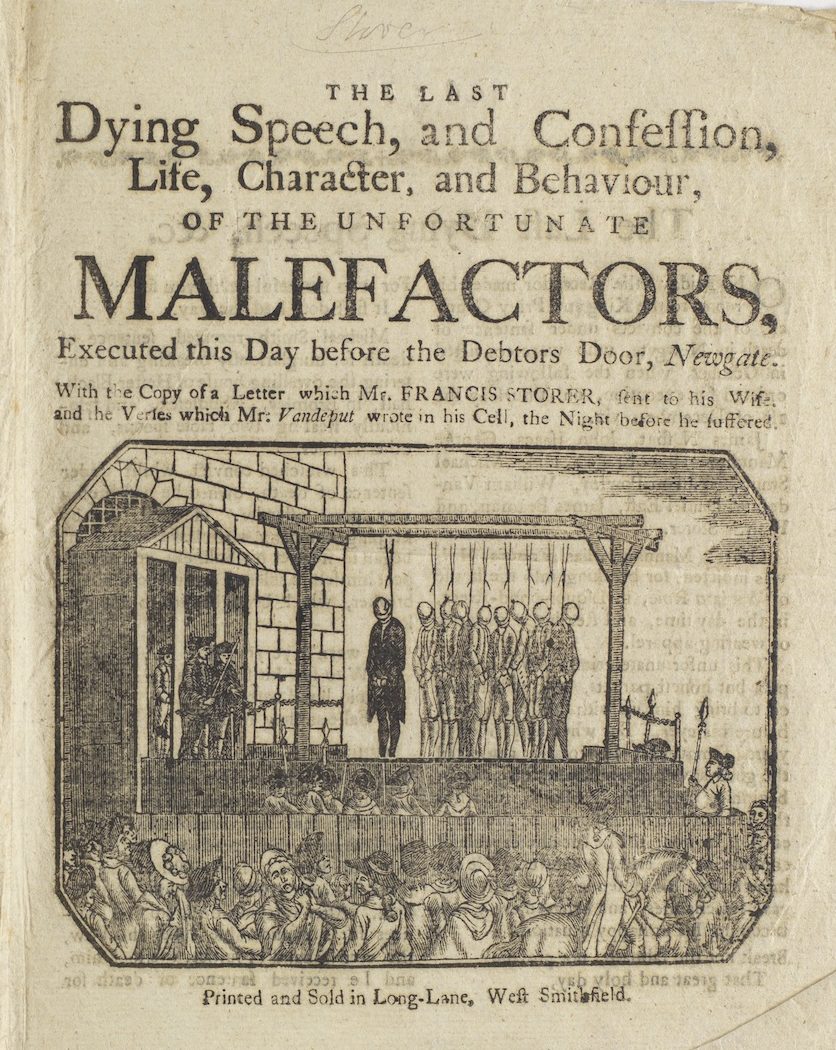
These qualities were also frequently evoked in visual depictions of the Drop, of which there were many.[27] The plate published by the Gentleman’s Magazine is a case in point (Fig. 1). With the aid of conventions drawn from scientific illustration, the gallows is reduced to a machine like any other, its various features clearly labeled and explained. The elegant capitals and cursive script of the title and legend, the neat hatching and cross-hatching of the etcher’s hand, and the insistent perpendicularity of the whole design all conspire to make this a most orderly image—as polished and polite as the Magazine’s presumed readership. A similar overall effect is to be found in the woodcuts that adorned the published “last dying speeches” of the Newgate hanged (Fig. 6). The area nearest to the gallows has been populated by sheriffs and armed guards, and the fenced-off space beyond it by a large but decorous crowd, most of whom gaze up toward the scaffold with much the same focus and attention as the city officials. At the very center of the print, nine hooded men dangle slackly from the gallows frame. Hands pinioned, heads listing gently to one side, they appear already dead.
In many ways, images such as this one resemble the earlier woodcuts of executions at Tyburn. The condemned show no sign of struggle or distress. On the contrary, their doll-like bodies seem uncannily still, meek, and at peace. One key difference, however, is that this woodcut is not composed of a single block, but rather two, or perhaps three: the framing scene, comprising everything except the hanged men; and then the men themselves, whom the printer has slotted in—one single, heavily inked figure at left and a group of eight at right—to suit the number killed on this particular execution day. The operation was easily and often repeated, as two slightly later examples attest (Figs. 7 and 8). It is as if we are bearing witness to the very process Skinner and Turner narrate, whereby, with the mere flick of a wrist, a group of sentient “Convicts” has been transformed into so many “unhappy Objects.” The prints’ modular design both replicates and naturalizes the chillingly neat aesthetic of the device they depict, which excelled at turning live bodies into lifeless corpses with unprecedented order, propriety, and speed.
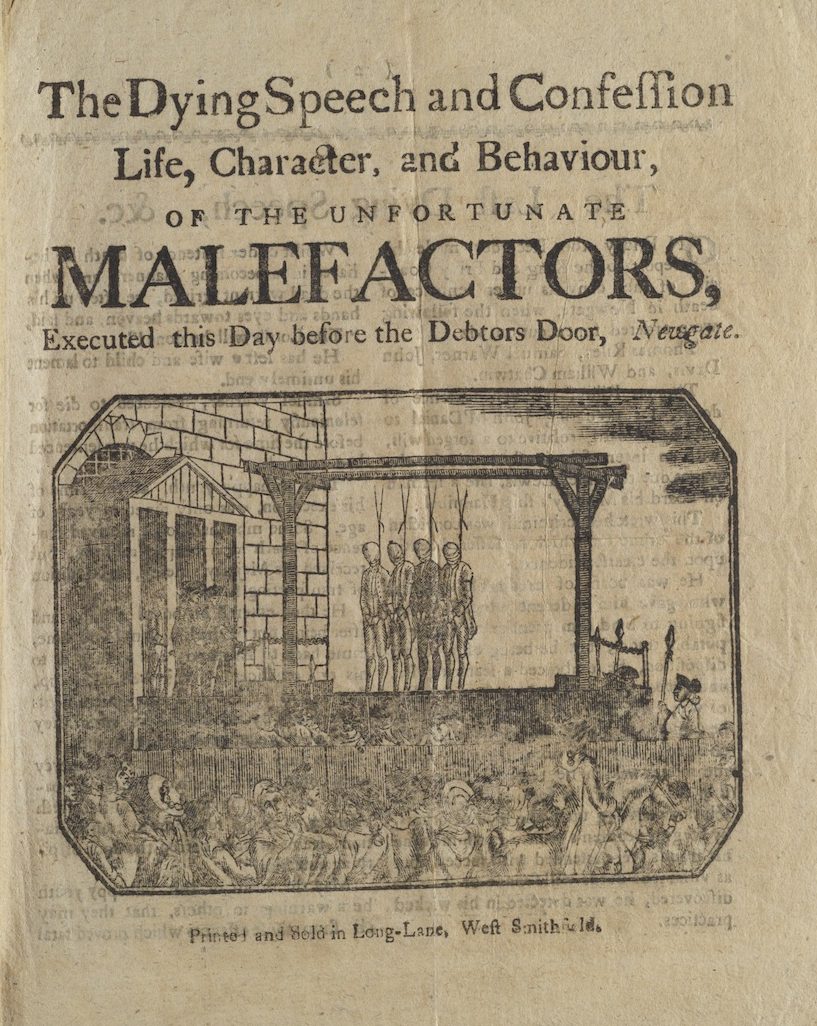
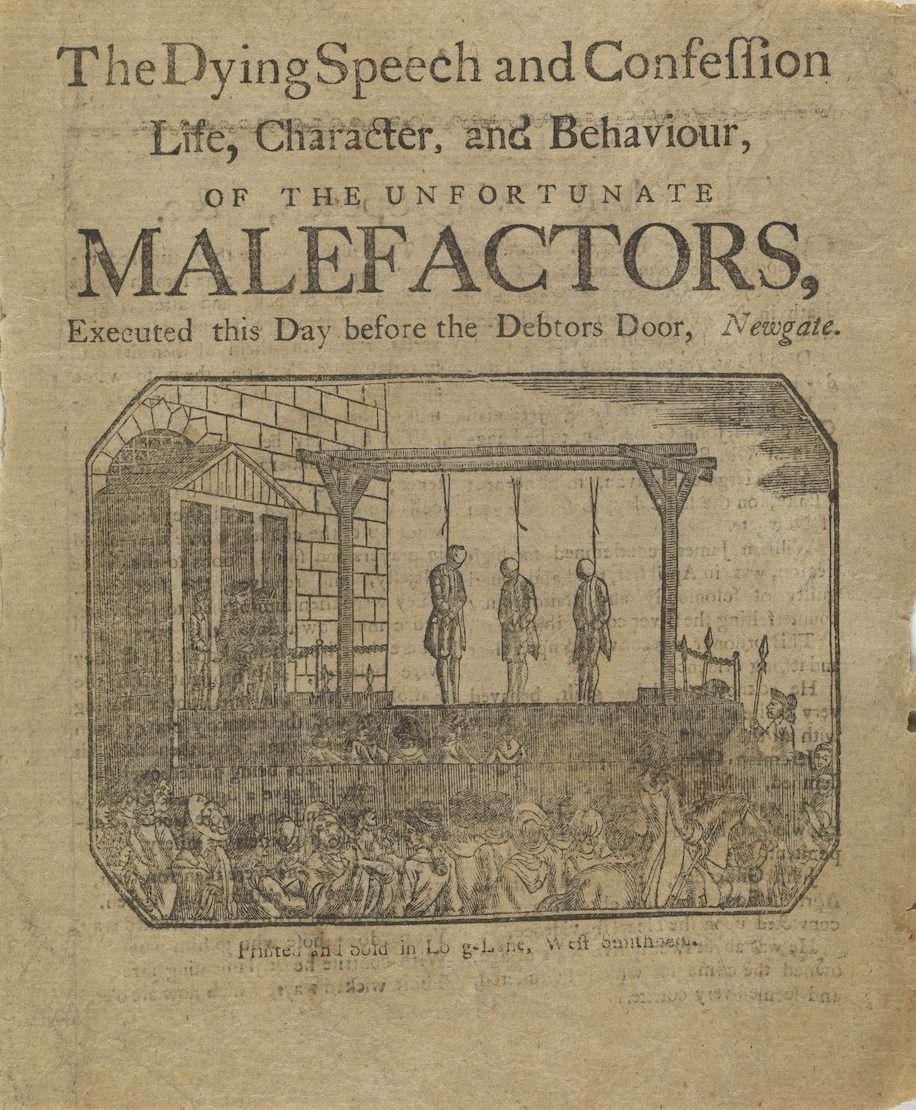
Demerara, 1823
Britain’s older forms of spectacular punishment did not disappear with the coming of its first mechanical gallows; instead, they were displaced from metropole to colony, from white bodies to Black and Brown ones. Forty years after the Newgate Drop was unveiled in London, rebellion broke out in the British colony of Demerara. A lucrative source of sugar, coffee, and cotton, Demerara was inhabited at the time by some seventy-seven thousand enslaved Africans and African-descended people and a tiny minority of white planters, who maintained power through a brutal system of oppression.[28] In the summer of 1823, following the arrival of a series of government dispatches ordering the amelioration of slave conditions, reports began to circulate among the enslaved that Britain’s Parliament had passed a new law granting their freedom.[29] On the belief that their rights were being violated, a group of them plotted an uprising. At around six o’clock on the evening of Monday, August 18, an estimated nine to twelve thousand slaves rallied to the sound of shell-horns and drums. They surrounded the main houses of some sixty plantations, locked overseers and managers in the stocks, and commandeered their arms and ammunition.[30] Colonial troops responded swiftly with lethal violence. In the span of three days, 255 rebels were killed or wounded, and dozens more executed soon thereafter.[31]
The rebellion in Demerara was one of the largest in Caribbean history, but it was not unique. As generations of historians have shown, slave insurrections were regularly staged and ruthlessly quelled across the Atlantic world throughout the eighteenth and early nineteenth centuries.[32] What is unusual is that the main events of this rebellion were documented visually by the London-trained artist Joshua Bryant in his Account of an Insurrection of the Negro Slaves in the Colony of Demerara (1824).[33] Dedicated to the colony’s Lieutenant-Governor, John Murray, Bryant’s Account claims to offer readers “a plain Narrative of facts” concerning the rebellion’s outbreak and suppression.[34] Over the course of some one hundred pages, it provides a minutely detailed chronicle, complete with transcriptions of government proclamations, trial testimony, and eye-witness accounts. Above all, however, Bryant seems to have devised his emphatically pro-colonist Account as a means of promoting his artistic ambitions among Demerara’s colonial elite.[35] To this end, he appended to the book a set of thirteen etched and aquatint plates, which conclude with several views of the rebellion’s violent aftermath.
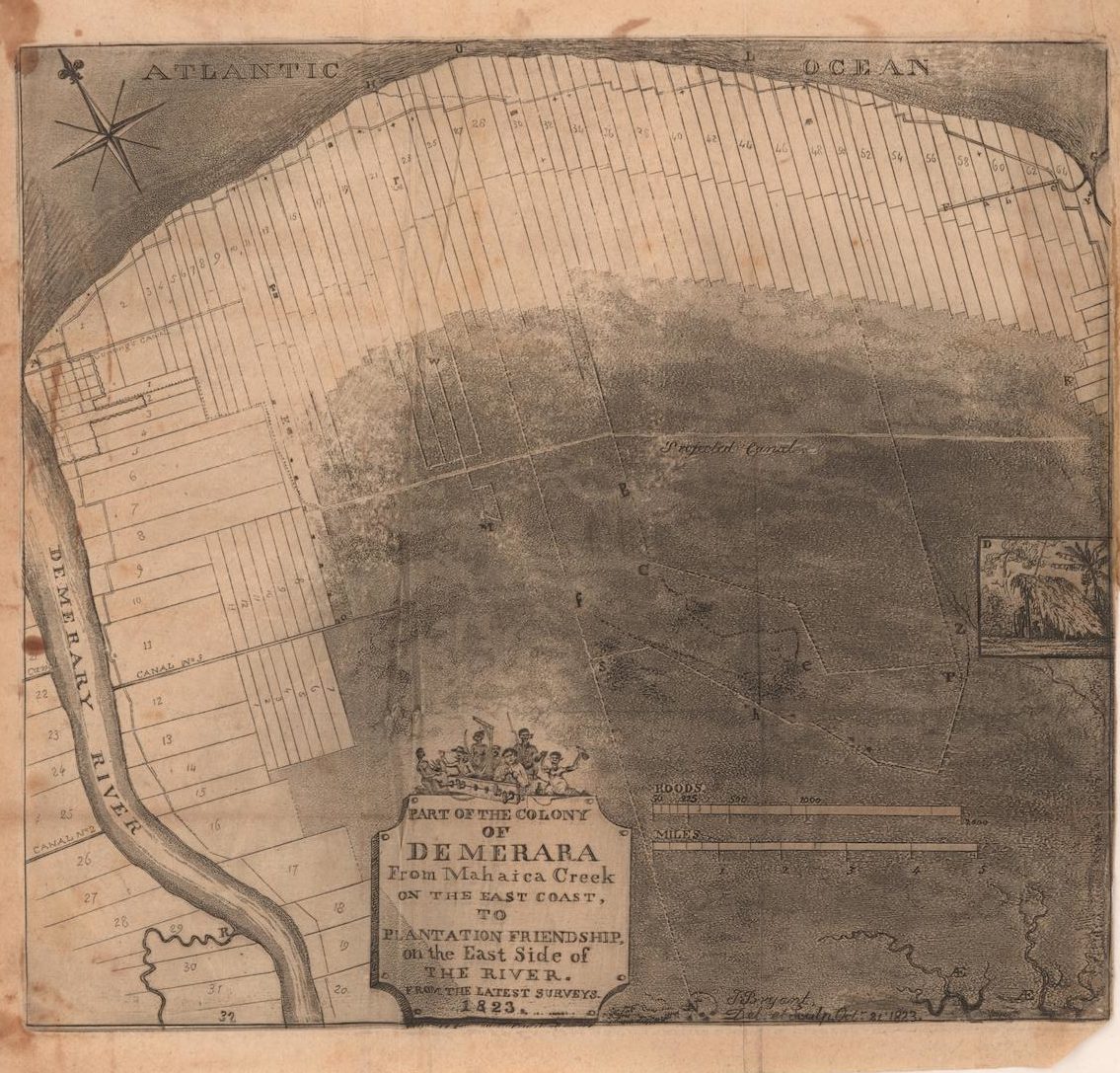
The punishments Bryant depicts in these scenes are presaged from the very beginning, in the large fold-out map that appears opposite the Account’s title page (Fig. 9). The accompanying description provides a numbered list of Demerara’s 110 plantations, before calling attention to the “double line extending along the Coast, [which] represents the public road,” along which “small crosses … point out where the rebels, or their heads, are exhibited, in terrorem” (Fig. 10). A list follows:
On plantation Plaisance [14] is the head of Attilla.
On plantation Success [21] are the bodies of Quamina and Richard in chains.
On plantation La Bonne Intention [23] the body of Lindor.
On plantation Beterverwagting [24] is Achilles.
On plantation Annandale [31] is Sandy.
On plantation New Orange Nassau [33] two heads.
On plantation Friendship [34] the body of Paul hangs in chains.
On plantation Bachelor’s Adventure [41] Telemachus and Jemmy on one jibbet.
On plantation Nabaclis [48] are the heads of Calib and Sloane.[36]
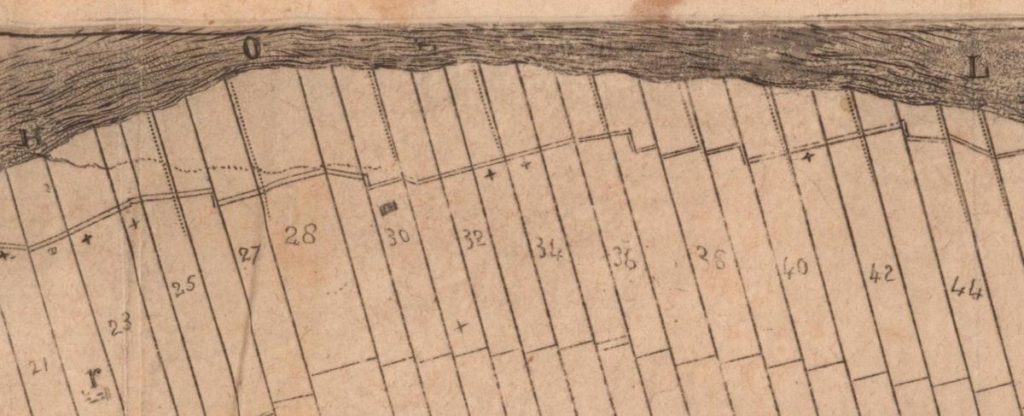
Through a radically abstracted symbolic language, the crosses chart a topography of terror, the creation of which is narrated in painstaking detail over the course of Bryant’s text. Thus we are told that, in the days after the uprising, the rebels January and Edward were “sentenced to be shot,” and their bodies “hung up on the draw-bridge, between Clonbrook and Ann’s Grove.”[37] That Beard was “tried summarily by the Officers, who immediately found him guilty; after which he was marched over to the Clonbrook, and there shot.”[38] That Allick “was led forth as a prisoner, in presence of the whole gang, and, with the negro Dublin … was tied to a cabbage-tree and shot.”[39] That Toby, Jim, and Hill were “executed on the following Tuesday, at Beterverwagting,” and that more captured rebels were shot soon after at the plantations Success, Lusignan, and Nabaclis.[40]
On August 26, the hangings began. A gallows was erected at the Parade-Ground, in Cummingsburg, Georgetown, and at five o’clock that evening, the rebels Natt and Louis were escorted there by a procession consisting of armed guards and coffin-bearers, a chaplain and marching band, and hundreds of militiamen.[41] Two days later, the same was repeated for Damas, Daniel, Philip, and Evan; and in the coming weeks, for Ellick, Attilla, France, Billey, Harry, Quintus, Telemachus, Scipio, Lindor, Pickel, Beffany, Tom, Paul, and Quamina.[42] In many cases, the men’s bodies were subsequently dismembered and displayed. Bryant’s tenth plate shows the decapitated heads of ten unnamed rebels “elevated on lofty poles” and arrayed along the coast, not far from a “jibbet erected for the ring-leader Paris” (Fig. 11). The corpses of at least five others were gibbeted on the plantations where they had been enslaved.
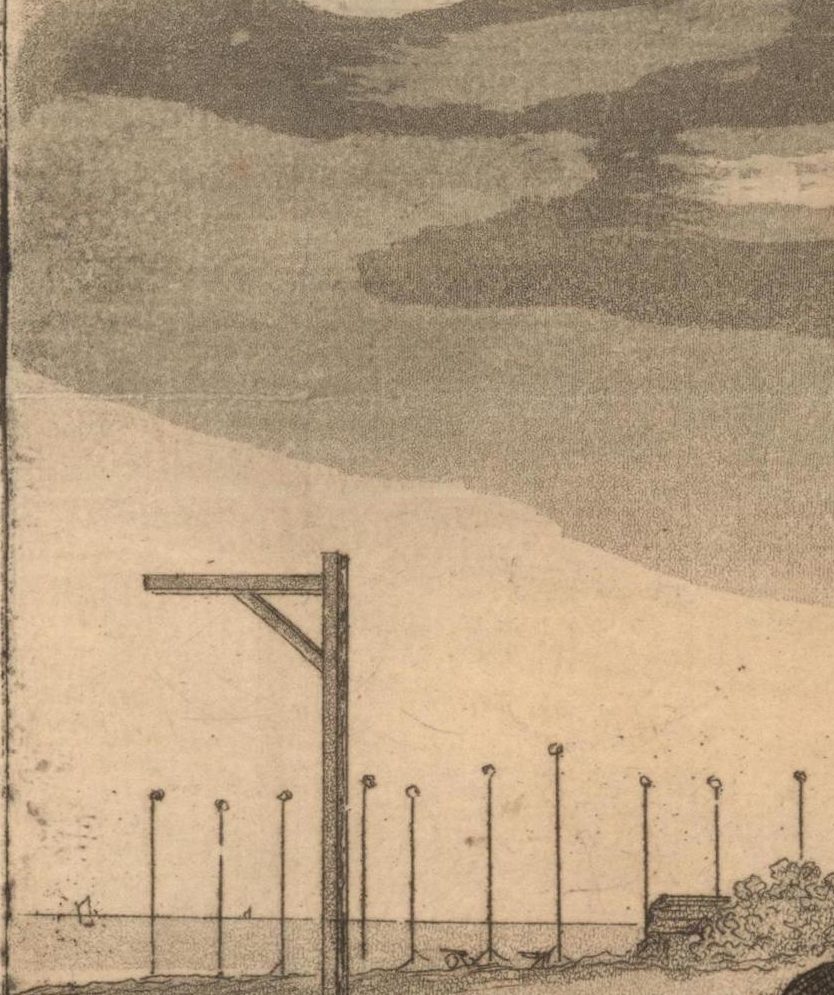
Bryant did not picture the summary executions of January, Edward, Beard, Allick, Dublin, Toby, Jim, or Hill. But he did devote two fold-out plates to the spectacles that followed. The first of these shows the parade-ground at Cummingsburg, seen from a distance under a cloudy, windswept sky (Fig. 12). At the very center of the plate stands a large gallows. Four timber braces support its wide wooden frame, which is accessed by a tall stair and stocked with seven nooses. Like the Newgate Drop, this must have been a trap door gallows, but one that was significantly less well-designed, for Bryant notes that on several occasions ropes broke and knots slipped upon its opening.[43] Three small, dark figures stand on the platform, presumably some about to be hanged. Yet they are dwarfed by the land and figures all around: the disciplined rows of militiamen that enclose the site; the clusters of seated spectators and lone passersby; the lush foliage and large houses beyond; and the low, flat expanse of the parade-ground itself.
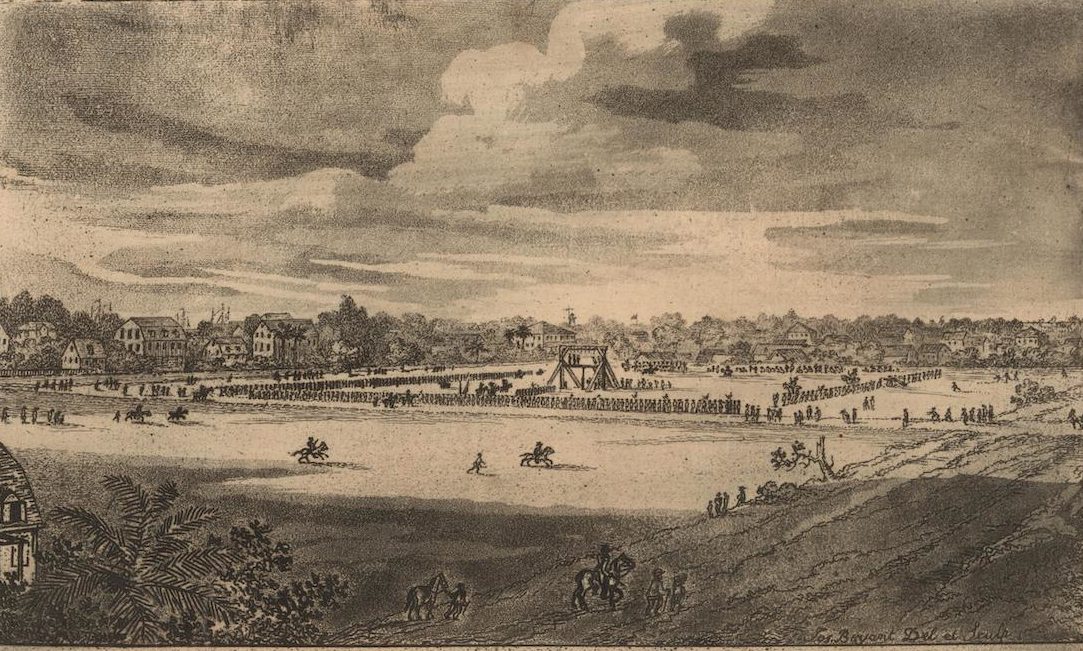
By contrast, the bodies of the dead are brought close in the Account’s final illustrated plate (Fig. 13).[44] Divided into four quadrants, it shows the corpses of five of the rebellion’s leaders hanging from wooden gibbets. In the accompanying plate description, Bryant specifies when he recorded them—“the 20th of September, 1823”—as well as who is shown, and where: “1st, Quamina, on plantation Success. 2d, Lindor, on La Bonne Intention. 3d, Paul, on the Friendship, … 4th, Telemachus and Jemmy, on Bachelor’s Adventure.”[45] The men are suspended by ropes or chains, their slumped, stiffened bodies encased in metal braces. Variously mirrored and set off by a range of surrounding features—willowy palm trees, patches of lit ground and dark scrub, and the grotesque repoussoir device of two decayed heads on pikes—they are visualized through the well-worn conventions of picturesque landscape painting. In other words, Bryant offers them to us as objects of aesthetic contemplation.
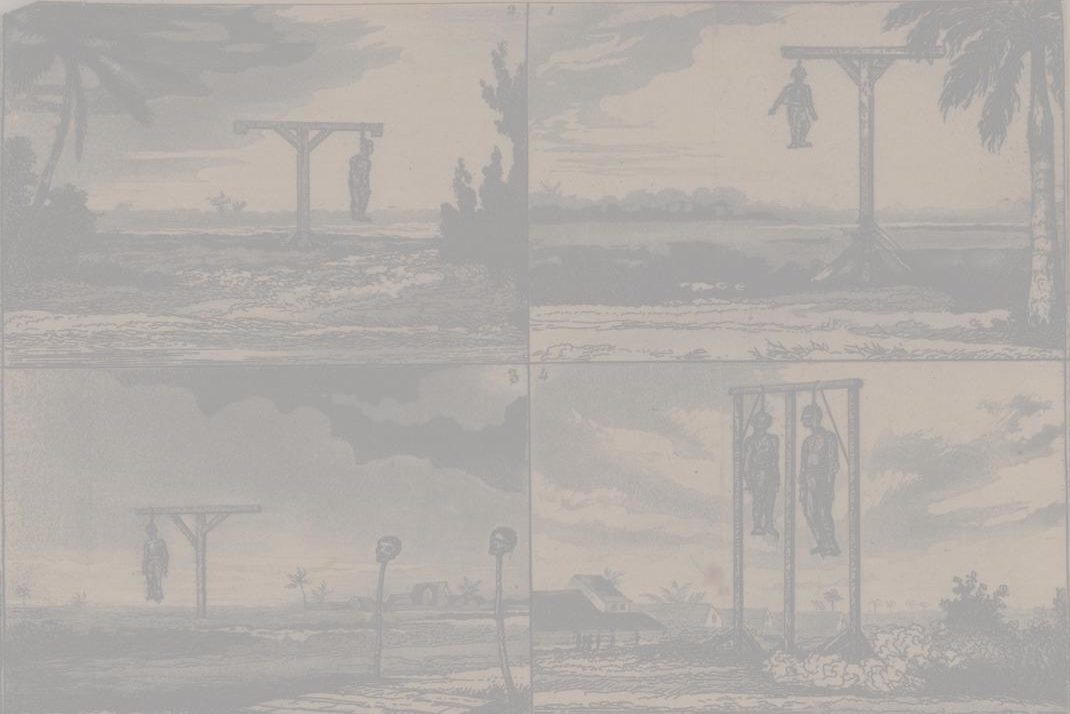
Produced decades after the introduction of the Newgate Drop, Bryant’s plates document the survival and reinvention of an ancient penal style, descended from the one Ibn Fadhlan described and Pisanello drew many centuries earlier, in which the executed body was fixed in the landscape and left to the elements, a semi-permanent monument to the power of those who put it there.[46] In this new context, its chief and stated purpose as an instrument of terror remained.[47] Yet Bryant’s Account makes clear that another motivation was at work as well, for his views were in no way made for the eyes of the enslaved. Bryant published his book in Georgetown, Demerara’s capital city, and he successfully marketed it to over 300 subscribers there and elsewhere in the Caribbean, including Barbados, Berbice, Jamaica, and Trinidad.[48] For this audience, Bryant’s prints—and no doubt also the spectacles they showed—were not objects of terror, but, on the contrary, sources of pleasure and comfort, designed to bolster the identity and allay the anxieties of a dominant yet precarious white planter class.
Rings, Ropes, and Trees
Slavery was abolished in most parts of the British empire in 1833. The last public hanging in Britain took place thirty-five years later, after which executions moved behind prison walls. However, the reformed image of hanging that originated with the Newgate Drop and the spectacles of racialized violence forged in Britain’s slave colonies lived on in altered form.
In Britain, the removal of executions from view initiated an era of experimentation and “improvement” in the awful science of hanging. In the late nineteenth century, the Home Office ordered its Surveyor’s Department to design a new gallows at Newgate, plans for which were circulated to Britain’s colonies soon thereafter along with detailed instructions for its use.[49] The short-drop method, which was employed at Tyburn and the Newgate Drop, gave way to the long drop, which killed more quickly; tables of calculations were devised to control the force and pressure of the condemned’s fall; and burnished brass rings, or “eyes,” replaced the traditional slip-knot as a more reliable means of tying and tightening the noose.[50]
We catch a glimpse of these transformations in an article published by London’s Picture Post in May 1948. The previous month, the House of Commons voted in favor of a bill to suspend the death penalty in the United Kingdom for five years, leading the Post—prematurely, as it turned out—to sound the death knell of hanging in Britain.[51] Included among the article’s grainy grey-tone photographs of infamous murderers, prison gates, and black-capped judges is a large, aerial view of an employee at a factory in Old Kent Road, South London, bearing the caption “A Work That May No Longer Be Needed” (Fig. 14).[52] Respectably dressed in a coat, tie, and white collared shirt, the man leans back to reveal a table full of artfully arranged hangman’s ropes. Several rest in neat, snake-like coils, bundled with twine; another unspools across the picture plane, showing off its length and uniformly regular twisted strands. Each noose is fitted with a metal eye and rubber stopper, more of which cluster in piles nearby. In post-war Britain, this was the closest most Britons came to seeing the hangings carried out in their name, and it is no accident that the picture of capital punishment constructed here presents it as an essentially technical affair—free of bodies, blood, and pain—in much the same way as the Gentleman’s Magazine had done a few centuries before (Fig. 1).

At the same time that Britain was replacing slip-knots with steel rings, a different metamorphosis of the hangman’s noose was unfolding across the Atlantic. Hanging arrived in North America with the first British colonial settlements, and it remained the universal method of judicial execution until long after American independence.[53] In the late 1880s, however, states began actively seeking alternatives. The electric chair was introduced in New York in 1890, and the gas chamber in Nevada in 1921. By 1955, one or the other had been adopted in an additional 35 states.[54] This sudden and rapid shift was motivated less by objections to hanging per se, than by the taint of association. Between 1865 and 1950, nearly 6,500 Black Americans—more than twice as many as the estimated three thousand Londoners hanged over the whole of the eighteenth century—were killed in documented white mob lynchings.[55] As hanging increasingly came to be seen as a tool and symbol of racial terror, legislators were quick to dispense with it as a legal means of execution.[56]
The long arc of this history was one of many legacies explored by the American artist Kara Walker in her monumental public sculpture Fons Americanus (Fig. 15). Commissioned for Tate Modern’s Turbine Hall, where it stood from October 2019 to February 2021, Walker’s work offered a witty, scathing, and layered reflection on Britain’s imperial history, seen through the eyes of one of its self-described “cultural subjects.”[57] The sculpture, which was intentionally destroyed soon after its exhibition at Tate, paid ironic homage to an earlier monument to the British empire, London’s Victoria Memorial, first unveiled in 1911 outside Buckingham Palace.[58] On every level, in every way, Fons Americanus subverted the precedent of its model. In lieu of marble, bronze, and gold, Walker employed recyclable cork, metal, and jesmonite-coated wood. Instead of polished surfaces and legible forms, she bestowed on her figures the rough-hewn look of clay maquettes. And in place of a triumphalist narrative of territorial and naval might, she substituted a time-twisting allegory of the Black Atlantic.
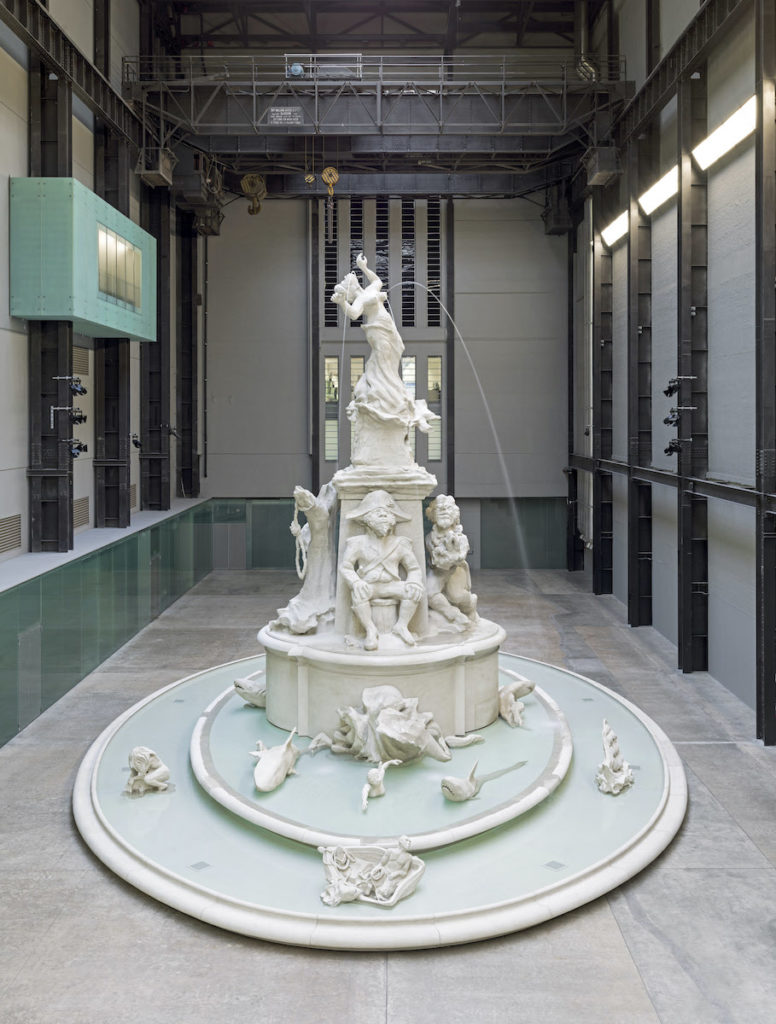
The word fons means “source” in Latin, and Fons Americanus was a sculpture about sources, at once literal and metaphorical. The inheritances Walker invoked ranged widely, from the paintings of John Singleton Copley, J.M.W. Turner, and Winslow Homer to the deities of Candomblé and Santeria; from the lives of Toussaint L’Ouverture, Marcus Garvey, Paul Cuffee, and Paul Robeson to the martyrdom of Emmett Till.[59] Amidst all of these, Walker invoked another inheritance as well. On the north side of the monument’s quatrefoil pedestal, she planted a blasted tree stump with an empty noose dangling from one branch (Fig. 16). Absent a victim, it was the tree itself that here seemed to be suffering. With its limb-like arms splayed up toward the sky, split-open trunk, and fleshy orifice below, it recalled one of Western art’s many images of bodies in pain: a flayed Marsyas, butchered ox, or Christian saint. An unmistakable reference to the United States’ long and ongoing history of racial terror, “the Angel,” as Walker titled this figure, traced the specter of the lynch mob straight back to British soil.[60]
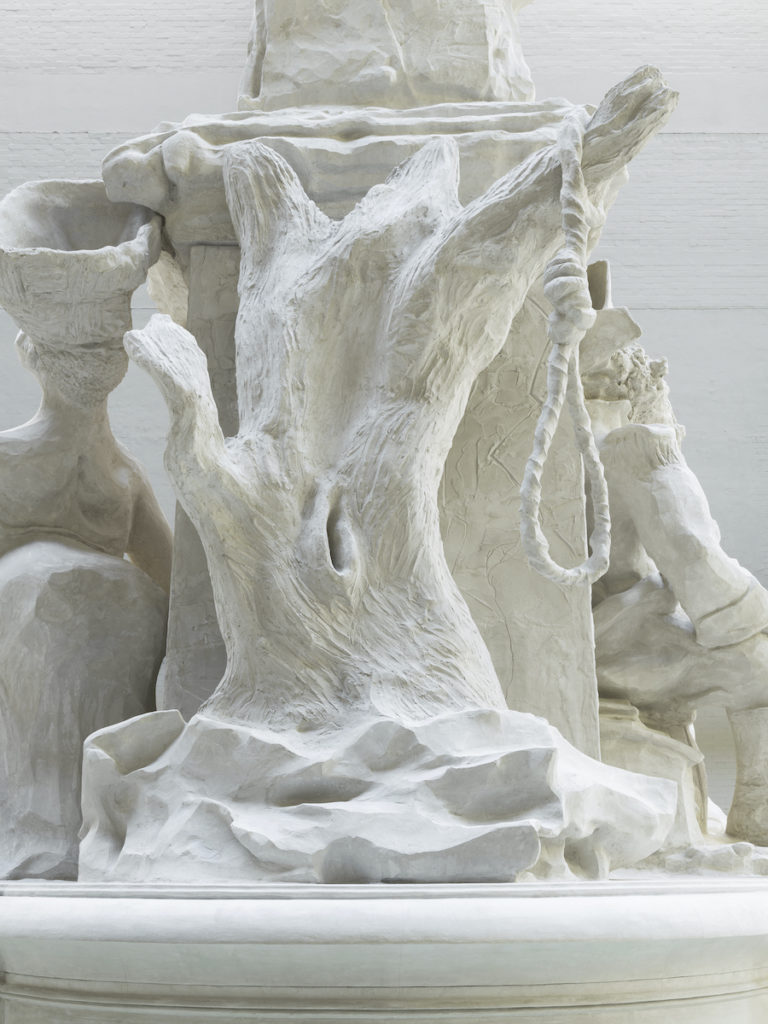
In doing so, Walker called attention—as she so often does in her work—to a past that is not past, to a “long eighteenth century” that is still unfolding. As the Angel suggests, and Bryant’s plates confirm, the history of lynching in America, and the spectacularization of Black suffering that it both fed on and fueled, is not only a national story but an imperial one as well. If the eighteenth century bequeathed to us the guillotine and Newgate Drop, machines that foretold the nineteenth-, twentieth-, and now twenty-first-century push toward ever more sanitized and invisible execution methods, it also laid the foundation for a nineteenth-, twentieth-, and now twenty-first-century American visual culture defined by the sight of Black bodies in pain.
Meredith Gamer is Assistant Professor in the Department of Art History and Archaeology at Columbia University, NY
Acknowledgments: I would like to thank Sarah Betzer and Dipti Khera for guiding this article to publication; Sussan Babaie, Maggie Cao, Andrei Pop, and Bart Pushaw for their thoughtful questions and comments; and the two anonymous reviewers for Journal18 for their valuable suggestions for revision. I am also grateful to the following colleagues for reading and offering generous feedback on earlier versions of the text: Tim Barringer, Esther Chadwick, Jennifer Nelson, Susanna Newbury, Joseph Rezek, Nicholas Robbins, Holly Shaffer, Dorothea von Mücke, and Hannah Weaver.
[1] Michel Rolphe Trouillot, Silencing the Past: Power and the Production of History (Boston: Beacon, 1997), 15. Quoted in Christina Sharpe, In the Wake: On Blackness and Being (Durham: Duke University Press, 2016), 9.
[2] “A New Place of Execution,” The Gentleman’s Magazine 53 (December 1783), 990.
[3] On the visual and cultural impact of the guillotine, see in particular Daniel Arasse, La guillotine et l’imaginaire de la terreur (Paris: Flammarion, 1987); Ludmilla Jordanova, “Medical Mediations: Mind, Body and the Guillotine,” History Workshop 28 (1989), 39-52; Dorinda Outram, The French Body and the French Revolution: Sex, Class and Political Culture (New Haven: Yale University Press, 1989); Regina Janes, “Beheadings,” Representations 35 (1991), 21-51; Pascal Dupuy and Caroline Bourgeois, “La représentation de la République française à travers les gravures satiriques et la presse quotidienne anglaise,” Annales historiques de la Révolution française 289 (1992), 367-381; Nina Athanassoglou-Kallmyer, “Géricault’s Severed Heads and Limbs: The Politics and Aesthetics of the Scaffold,” The Art Bulletin 74:4 (1992), 599-618; Ewa Lajer-Burcharth, Necklines: The Art of Jacques-Louis David (New Haven: Yale University Press, 1999); Richard Taws, “The Guillotine as Anti-Monument,” Sculpture Journal 19:1 (January 2010), 33-48; Stephanie O’Rourke, “Beholder, Beheaded: Theatrics of the Guillotine and the Spectacle of Rupture,” in Visual Culture and the Revolutionary and Napoleonic Wars, ed. Satish Padiyar, Phil Shaw, and Philippa Simpson (London: Routledge, 2016), 25-39; and Marc Gotlieb, “The Guillotine Sublime,” in Is Paris Still the Capital of the Nineteenth Century?: Essays on Art and Modernity, 1850-1900, ed. Hollis Clayson and André Dombrowski (London: Routledge, 2016), 53-72.
[4] For example, Michel Foucault, Discipline and Punish: The Birth of the Prison, trans. Alan Sheridan (New York: Pantheon Books, 1977; New York: Vintage Books, 1995), 13. Originally published as Surveiller et punir: naissance de la prison (Paris: Gallimard, 1975). Citations refer to the Vintage edition. See also O’Rourke, “Beholder, Beheaded,” and Gotlieb, “The Guillotine Sublime.”
[5] Francis Grose, A Classical Dictionary of the Vulgar Tongue (London: S. Hooper, 1785), under “T H R.” Grose’s comment appears in his entry for “Three-Legged Mare, or Stool,” which he defines as “The gallows, formerly consisting of three posts, over which were laid three transverse beams. This clumsy machine has lately given place to an elegant contrivance, called the new drop, by which the use of that vulgar vehicle a cart, or mechanical instrument a ladder, is also avoided.”
[6] Foucault, Discipline and Punish, 1-31. The guillotine, Foucault writes, “takes life almost without touching the body, just as prison deprives of liberty or a fine reduces wealth. It is intended to apply the law not so much to a real body capable of feeling pain as to a juridical subject, the possessor, among other rights, of the right to exist” (13). The Newgate Drop was designed to do much the same.
[7] See Saidiya V. Hartman, Scenes of Subjection: Terror, Slavery, and Self-Making in Nineteenth-Century America (New York: Oxford Press, 1997), esp. 3-14; Lose Your Mother: A Journey Along the Atlantic Slave Route (New York: Farrar, Straus and Giroux, 2007), esp. 136-153; “Venus in Two Acts,” Small Axe 12:2 (2008), 1-14; and Wayward Lives, Beautiful Experiments: Intimate Histories of Social Upheaval (New York: W. W. Norton, 2019), esp. 13-35.
[8] Hartman, “Venus in Two Acts,” 7. On violence, slavery, and the ethics of historical representation, see also Marisa J. Fuentes, Dispossessed Lives: Enslaved Women, Violence and the Archive (Philadelphia: University of Pennsylvania Press, 2016), esp. 1-12.
[9] Of Blackness and visibility, Hartman writes, “The paradox, simply put, is: one is most visible when most subjected.” Hartman, “Excisions of the Flesh,” in Lorna Simpson: For the Sake of the Viewer, ed. Beryl Wright (Chicago: Museum of Contemporary Art, 1992), 55. I wish to thank Oluremi Onabanjo for calling my attention to this essay.
[10] Temi Odumosu, “The Crying Child: On Colonial Archives, Digitization, and Ethics of Care in the Cultural Commons,” Current Anthropology 61:S22 (October 2020), S289-S302.
[11] On the origins of the hangman’s noose, see Jack Shuler, The Thirteenth Turn: A History of the Noose (New York: PublicAffairs, 2014), 19-20.
[12] Shuler, Thirteenth Turn, 11. On Greece, see Eva Cantarella, “Dangling Virgins: Myth, Ritual and the Place of Women in Ancient Greece,” Poetics Today 6:1/2 (1985), 91-101. On Scandinavia and Tacitus, see Shuler, Thirteenth Turn, 31-3.
[13] Shuler, Thirteenth Turn, 33; and see Ibn Fadlan’s Journey to Russia: A Tenth-Century Traveler from Baghdad to the Volga River, trans. Richard N. Frye (Princeton, NJ: Markus Wiener), 63-71.
[14] Esther Cohen, “Symbols of Culpability and the Universal Language of Justice: The Ritual of Public Executions in Late Medieval Europe,” History of European Ideas 11 (1986), 411.
[15] The origins and development of eighteenth-century Britain’s so-called “Bloody Code” have been a central topic of British historical debate for the past half-century. In particular, see Douglas Hay et al., Albion’s Fatal Tree: Crime and Society in Eighteenth-Century England (New York: Pantheon Books, 1975); Joanna Innes and John Styles, “The Crime Wave: Recent Writing on Crime and Criminal Justice in Eighteenth-Century England,” Journal of British Studies 25:4 (1986), 380-435; V. A. C. Gatrell, The Hanging Tree: Execution and the English People 1770-1868. (Oxford: Oxford University Press, 1994); and Peter Linebaugh, The London Hanged: Crime and Civil Society in the Eighteenth Century (London: Verso, 2003).
[16] Recent work by Simon Devereaux has shown that between 1730 and 1837, London’s central criminal court, the Old Bailey Sessions House, produced substantially more capital convictions and executions in absolute terms than any other urban jurisdiction in Britain, Europe, or the Atlantic world. In some British North American cities, such as Philadelphia and Charleston, per capita execution rates were even higher than in London. On London, see Simon Devereaux, “The Bloodiest Code: Counting Executions and Pardons at the Old Bailey, 1730-1837,” Law, Crime and History 6:1 (2016), 83-102; on Philadelphia and Charleston, see Gabriele Gottlieb, “Theater of Death: Capital Punishment in Early America, 1750-1800” (Ph.D. thesis, University of Pittsburgh, 2005), 95-96.
[17] Over three times this many were found guilty of capital crimes and sentenced to death, only to have their sentences commuted or pardoned. See Devereaux, “The Bloodiest Code,” 83.
[18] Devereaux, “The Bloodiest Code,” 3-4.
[19] Julius Ruff, Violence in Early Modern Europe, 1500-1800 (New York: Cambridge University Press, 2001), 110.
[20] On hanging as an “easy death,” see Solon Secundus: Or, Some Defects in the English Laws with Their Proper Remedies. By a Hearty Lover of His Country (London: John Whitlock, 1695), 6; and Bernard Mandeville, An Enquiry into the Causes of the Frequent Executions at Tyburn: And a Proposal for Some Regulations Concerning Felons in Prison, and the Good Effects to Be Expected from Them (London: J. Roberts, 1725), 36.
[21] Shuler, Thirteenth Turn, 23.
[22] Jonathan Green, Green’s Dictionary of Slang, https://greensdictofslang.com (accessed August 20, 2021). See also Peter Linebaugh, “The Tyburn Riots against the Surgeons,” in Hay et al., Albion’s Fatal Tree, 66-67.
[23] For example, in 1740, William Duell was hanged at Tyburn but revived on the dissection table at Surgeon’s Hall. See William Duell, News from the Dead, or a Faithful and Genuine Narrative of an Extraordinary Combat Between Life and Death (London: J. Roberts, 1740).
[24] Whitehall Evening Post or London Intelligencer (November 17-20, 1759); and Morning Chronicle and London Advertiser (May 5, 1778).
[25] The introduction of the Newgate Drop was part of a larger effort by Skinner and Turner to reform London’s execution ritual. See Simon Devereaux, “Recasting the Theatre of Execution: The Abolition of the Tyburn Ritual,” Past & Present 202:1 (2009), 140-143.
[26] Thomas Skinner and Barnard Turner, An Account of Some Alterations and Amendments Attempted in the Duty and Office of Sheriff of the County of Middlesex and Sheriffs of the City of London (London: Stephen Clark, 1784), 28-29. Detailed accounts of the new gallows and its operation also appeared in the Gazetteer and New Daily Advertiser (December 10, 1783), and Whitehall Evening Post (December 9-11, 1783).
[27] Other examples include Thomas Rowlandson, An Execution Outside Newgate Prison, c.1805, watercolor with pen and ink over graphite (Museum of London, A9267); George Cruikshank, Bank Restriction Note, 1819, etching (British Museum, 1868,0612.1650) and several political tokens dated c.1795 housed in the Department of Coins and Medals at the British Museum (1855,1004.324 and SSB,245.58).
[28] For detailed accounts of similar conditions in Jamaica and Barbados, respectively, see Vincent Brown, The Reaper’s Garden: Death and Power in the World of Atlantic Slavery (Cambridge: Harvard University Press, 2008) and Fuentes, Dispossessed Lives.
[29] These events and the ensuing rebellion are chronicled by Emília Viotti da Costa in Crowns of Glory, Tears of Blood: The Demerara Slave Rebellion of 1823 (New York: Oxford University Press, 1994). On the confusions arising from the government dispatches, see pp. 174-188.
[30] da Costa, Crowns of Glory, 198.
[31] da Costa, Crowns of Glory, 207-245.
[32] Seminal in this regard was C.L.R. James, The Black Jacobins: Toussaint L’Ouverture and the San Domingo Revolution (London: Secker and Warburg, 1938). For two recent reviews of and contributions to this vast historiography, see Aline Helg, Slave No More: Self-Liberation Before Abolitionism in the Americas, trans. Lara Vergnaud (Chapel Hill: The University of North Carolina Press, 2019), esp. 1-14; and Vincent Brown, Tacky’s Revolt: The Story of an Atlantic Slave War (Cambridge, MA: The Belknap Press of Harvard University Press, 2020), esp. 1-15.
[33] Sarah Thomas briefly notes the exceptional nature of Bryant’s plates in Witnessing Slavery: Art and Travel in the Age of Abolition (New Haven: Yale University Press, 2019), 99-124.
[34] Joshua Bryant, Account of an Insurrection of the Negro Slaves in the Colony of Demerara, which Broke Out on the 18th of August, 1823 (Demerara: A. Stevenson, 1824), vii.
[35] “The present Writer, who has constantly resided in the Colony for the last fifteen years, has, in his profession as an Artist, accumulated a variety of Graphic Studies from Nature,—and intends, if suitable encouragement offers, to publish in England a selection of the best, with additions from a new port-folio, which he proposes to form as soon as circumstances shall permit.” Bryant, Account, vi.
[36] Bryant, Account, 116-117.
[37] Bryant, Account, 41.
[38] Bryant, Account, 46-47.
[39] Bryant, Account, 47.
[40] Bryant, Account, 56, 58.
[41] Bryant, Account, 61.
[42] Bryant, Account, 64, 66.
[43] Bryant, Account, 63. “On Thursday, [August] the 28th, four rebels were found guilty, and escorted to the place of execution, at the usual hour of five o’clock, p.m. … At these executions, an unfortunate circumstance occurred. On the falling of the drop-board, three of the culprits were precipitated to the ground, in consequence of the accidental slipping of the knot.”
[44] The final plate in Bryant’s Account comprises a series of four maps referred to in the course of his narrative.
[45] Bryant, Account, 120.
[46] On the history of gibbeting in Britain, see Sarah Tarlow, The Golden and Ghoulish Age of the Gibbet in Britain (New York: Palgrave Macmillan, 2015). Though common in early modern and eighteenth-century Britain, the practice declined precipitously there after 1800 (34-35).
[47] Though this is by no means necessarily how they were interpreted by the enslaved. See Brown, Reaper’s Garden, 139-156, especially his discussion of the assassination of a “Mr. Dunbar” in Jamaica and subsequent heroization of his killer among the island’s slaves (136).
[48] Bryant, Account, 122-124. The subscription list includes the names of over 300 individuals, as well as entries for “Barbados” (which ordered 23 copies), “Berbice” (17), “Jamaica” (28), and “Trinidad” (14).
[49] Justin Atholl, Shadow of the Gallows (London: J. Long, 1954), 104. “Memorandum Upon the Execution of Prisoners by Hanging with a Long Drop, June 1880,” Queensland State Archives, Series ID 12690, Item ID 1139511; and “Circular from the Secretary of State for the Colonies, with Attached Plan and Section of the Gallows at Newgate Gaol, 28 December 1880,” Queensland State Archives, Series ID 12690, Item ID 1839168.
[50] These developments are chronicled in Atholl, Shadow of the Gallows, 98-119.
[51] Capital punishment was not abolished in the United Kingdom until seventeen years later, in 1965. It was retained for decades thereafter in many of Britain’s former colonies.
[52] Henry Rhodes, “Is There a Cure for Murder?” Picture Post 29:1 (May 8, 1948), 7-9, 28. Meanwhile, the note below the caption evoked the nation’s still vast but waning empire. “In Britain,” it explains, “a rope is used only once. In the Colonies, the same rope is used again, and comes back to the firm for overhaul after use.”
[53] In September 1630, John Billington became the first Englishman to be hanged on Patuxet land, in the settler colony of Plymouth. The last public hanging in the United States was that of Rainey Bethea on August 14, 1936. Hanging is still legal in Delaware, New Hampshire, and Washington.
[54] David Garland, Peculiar Institution: America’s Death Penalty in an Age of Abolition (Cambridge, MA: Belknap Press, 2010), 117. In 1982, both methods were superseded by lethal injection.
[55] These figures have been compiled and published in reports by the Equal Justice Initiative. See Lynching in America: Confronting the Legacy of Racial Terror (Equal Justice Initiative, 2017) and Reconstruction in America: Racial Violence after the Civil War, 1865-1876 (Equal Justice Initiative, 2020). The EJI’s figures include only documented cases; given the difficulty of documenting lynchings, the actual total is likely much higher.
[56] Garland, Peculiar Institution, 118-119. The noose remains a potent symbol of racial terror in America today, and state laws in Louisiana and New York prohibit its display (see 2009 Louisiana Laws TITLE 14 and New York Article 240.31; accessed October 18, 2021).
[57] Clara Kim, “An Allegory of the Black Atlantic,” in Kara Walker: Fons Americanus, ed. Clara Kim (London: Tate, 2019), 107.
[58] Kim, “An Allegory of the Black Atlantic,” 106.
[59] Kim, “An Allegory of the Black Atlantic,” 112-115.
[60] The connection is reinforced in the catalogue published to accompany the sculpture’s display at Tate. Among the source materials reproduced is a photograph of the lynching of Roosevelt Townes and Robert McDaniels in Duck Hill, Mississippi on April 13, 1937, and another of three white women picnicking and smiling beneath the “Hangman’s Tree,” a roadside tourist attraction in Tuolumne County, California. See Kara Walker: Fons Americanus, 94-95. The history of lynching in America has long been a theme in Walker’s work, most explicitly in Virginia’s Lynch Mob, 1998, cut paper on wall (Montclair Museum of Art, Montclair, NJ, 2016.9). On the intersection of violence, slavery, history, and memory in Walker’s art generally, see Gwendolyn Dubois Shaw, Seeing the Unspeakable: The Art of Kara Walker (Duke University Press, 2004), esp. 37-65.
Cite this article as: Meredith Gamer, “Britain, Empire, and Execution in the Long Eighteenth Century,” Journal18, Issue 12 The ‘Long’ 18th Century? (Fall 2021), https://www.journal18.org/5919.
Licence: CC BY-NC
Journal18 is published under a Creative Commons CC BY-NC International 4.0 license. Use of any content published in Journal18 must be for non-commercial purposes and appropriate credit must be given to the author of the content. Details for appropriate citation appear above.
